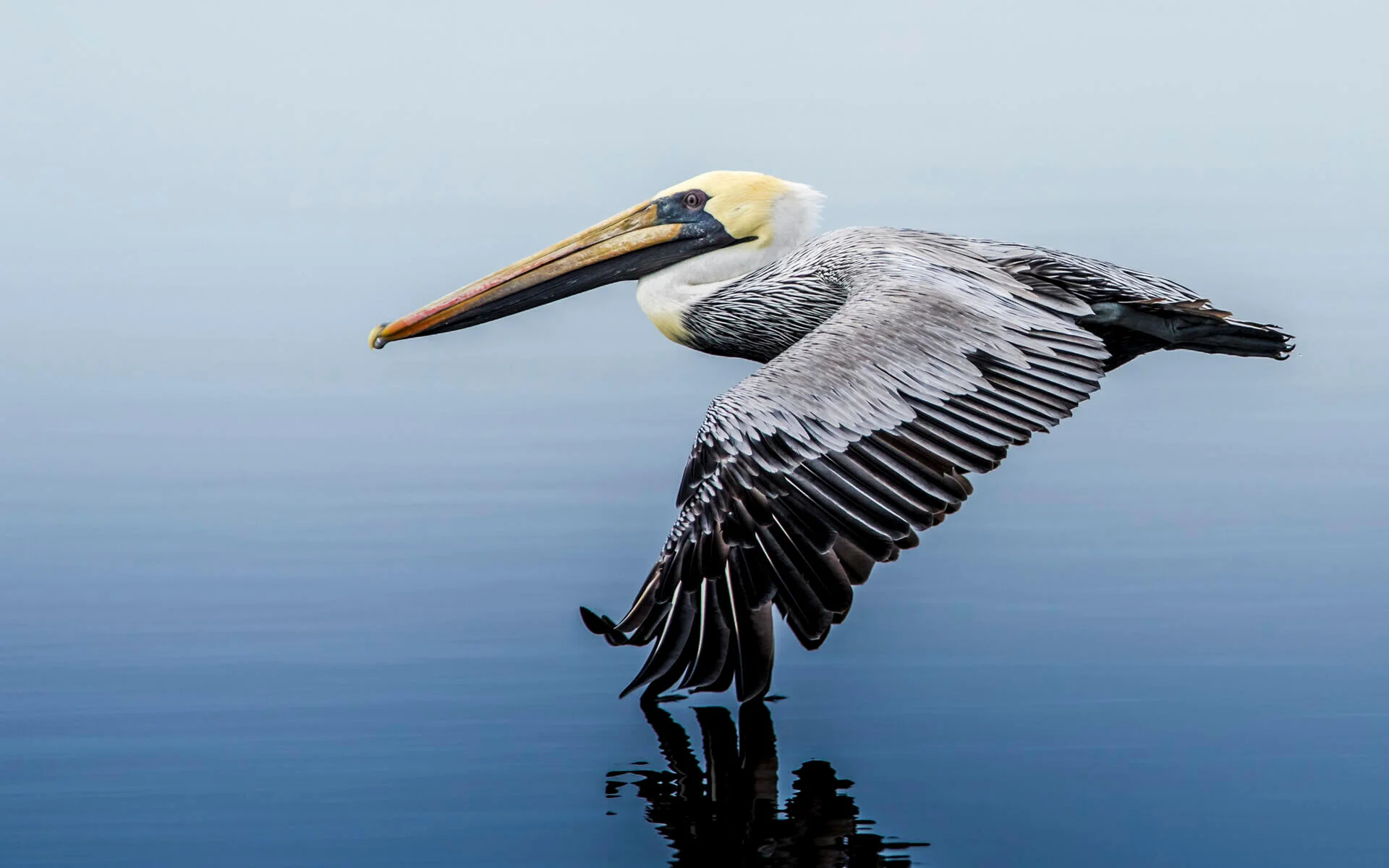In Ohio, you can come across both species of Pelican that exist in North America. These species include the American White Pelican and the Brown Pelican. American White Pelicans can be observed during their migration, while the presence of the Brown Pelican in Ohio is quite rare and infrequent.
Pelicans are renowned as one of the largest avian creatures worldwide, distinguished by their enormous bills, expandable throat pouches, and remarkable feet. Despite their size, they possess a lightweight structure due to air pockets in their skin and skeleton, allowing them to effortlessly float on water surfaces. Additionally, their elongated wings aid in their graceful soaring while in flight.
Globally, there are a total of eight pelican species, two of which inhabit North America, namely the American White Pelican and the Brown Pelican.
During the breeding season, pelicans undergo striking transformations in their facial skin, throats, and bills, which become more vibrant in color. Some individuals even develop additional features on their bills.
Pelicans are communal breeders, forming colonies that can consist of up to 50,000 birds. Depending on the species, these colonies may opt for ground or tree nests. After approximately 25 days of nesting, the young pelicans gather in “creches,” where groups of up to 100 juveniles congregate. Remarkably, the parents can recognize and solely nourish their own offspring.
Although pelicans do prey on other animals, they are not classified as birds of prey, as that category is reserved for raptors. Pelicans predominantly consume fish, but they also have the capacity to devour crabs, frogs, snakes, mammals, birds, and insects.
Their distinctive throat pouches serve as a tool to capture fish, enabling them to drain water before swallowing their prey. Additionally, young pelicans can directly feed from their parents’ pouches.
To assist in identifying the types of Pelicans encountered in Ohio, this guide utilizes information from Avibase and data contributed by bird watchers on eBird, providing authentic details regarding the timing of these birds’ appearances.
Pelicans Spotted in Ohio: 2 Species
American White Pelican

Although some individuals have been observed in Ohio throughout the year, the American White Pelican is primarily sighted during migration seasons, which occur from April to May and September to October. According to reports submitted by bird watchers, these pelicans appear in up to 3% of checklists during spring migration in the state.
With the second-largest average wingspan among North American birds, American White Pelicans are sizable avian creatures known for their soaring abilities.
During non-breeding periods, adult American White Pelicans possess an entirely white plumage, with black flight feathers visible only when they take flight or extend their wings. Their eyes are bluish-gray, and they have yellow facial skin encircling their eyes. Their bills, pouches, and feet exhibit a pale orange hue. On the other hand, juveniles exhibit light gray feathers with darker brown napes.
During the breeding season, adult American White Pelicans display distinct differences in coloration compared to non-breeding adults. They develop a yellow plate, resembling a horn, on their upper bills. While their bodies remain entirely white, their eyes, bills, legs, and feet take on a brighter orange shade.
American White Pelicans undergo various molting changes, referred to as “eclipse.” In spring, a visible yellowish patch appears on their breasts and chests, while in summer, their heads acquire blackish feathers.
- Pelecanus erythrorhynchos
- Length: 60 – 63 inches (152 – 160 cm)
- Weight: 246.4 ounces (6983 g)
- Wingspan: 96 – 110 inches (244 – 279 cm)
Breeding colonies of American White Pelicans are typically found in remote inland lakes across North America. For the winter season, they migrate to the southern Pacific Coast of the United States, the Gulf of Mexico, Mexico, and Central America. During migration, they can be spotted in various western and central US states.
American White Pelicans primarily inhabit shallow freshwater lakes, wetlands, and the fringes of lakes and rivers. In winter, they can be found in coastal bays, inlets, and estuaries, where they engage in foraging activities in shallow waters and rest on sandbars.
Their diet mainly consists of fish, which they capture by swimming near the water’s surface and skillfully using their large bills. They often engage in group foraging, strategically herding fish towards the shore, where they can efficiently scoop them up.
Moreover, American White Pelicans are opportunistic feeders, venturing far distances in search of more abundant feeding grounds. They may also consume crayfish, amphibians, salamanders, and even pilfer fish from other birds on the water’s surface.
In terms of vocalization, American White Pelicans are generally silent, emitting only occasional grunts. However, the young pelicans tend to be more vocal, particularly when requesting food in large colonies.
Their nests are simple, shallow depressions on the ground, with twigs, sticks, reeds, and other materials placed atop the soil to provide protection for the eggs.
During incubation, both parents jointly tend to one to two eggs for approximately thirty-six days. Unfortunately, due to siblicide, a phenomenon where one sibling eliminates the other, only one chick survives per nest.
Fun Fact: The massive bill of an American White Pelican can hold up to three gallons of water. When capturing fish from the sea, the pelican tilts its bill downwards, allowing water to drain out, enabling the bird to consume the remaining fish stored in its throat sac.
Brown Pelican

Brown Pelicans are infrequently observed or accidentally encountered in Ohio, primarily in the northern region of the state. The last recorded sightings were around Bath Nature Preserve in 2021.
Non-breeding adult Brown Pelicans typically possess white heads and necks, with pale yellow foreheads. Their long bills exhibit a combination of yellow and orange hues. Their bodies feature a grayish-brown coloration, accompanied by short black legs and webbed feet. Juveniles have brown heads, necks, backs, and wings, with bluish-gray bills and a light brown underside.
The Brown Pelican species comprises five subspecies, with two of them breeding within the United States. The Pacific Coast variant is known as P.o.californicus, while the Atlantic Coast variant is referred to as P.o.carolinensis.
During the breeding season, the distinctions between Pacific and Atlantic Brown Pelicans become more apparent. Both species exhibit white heads with pronounced yellow foreheads. However, their napes change from white to dark brown. Atlantic Brown Pelicans possess olive-brown throat pouches, while Pacific Brown Pelicans exhibit red skin within their throat pouches.
- Pelecanus occidentalis
- Length: 48 – 50 inches (122 – 127 cm)
- Weight: 131.2 ounces (3718 g)
- Wingspan: 78 – 84 inches (198 – 213 cm)
Brown Pelicans either breed, migrate, or remain resident year-round along the Pacific and Atlantic Coasts of North America, extending to northern South America.
These pelicans typically inhabit environments with shallow water. They establish year-round presence in estuaries and coastal marine habitats. Furthermore, they can be found on mangrove islets, sandbars, breakwaters, and offshore rocks, where they rest.
Brown Pelicans possess a remarkable foraging ability that sets them apart. They are capable of diving into deep ocean waters to capture their prey within their expandable throat pouches. Upon resurfacing, the pelican drains the water, allowing for immediate consumption of its catch.
Their diet predominantly consists of fish such as sardines and herring. When not diving, they casually swim and seize prey with their bills. Additionally, they may consume crustaceans like prawns, amphibians, eggs, and other young birds.
While adult Brown Pelicans are generally silent, emitting occasional grunts, juvenile pelicans vocalize more frequently, particularly when soliciting food.
Nests of Brown Pelicans are predominantly constructed on the ground rather than in trees. They seek out concealed and protected locations such as islands, mangroves, and cliffs. The female builds the nest using reeds, leaves, pebbles, sticks, and soil. The female lays two to four eggs, which are incubated by both parents for approximately one month.
Fun Fact: Brown Pelicans employ a unique incubation method by using their webbed feet to cover their eggs. However, this practice had adverse effects on the species when the pesticide DDT caused thinning of the eggshells, leading to breakages under the weight of the parents’ feet. It took extensive conservation efforts to restore the Brown Pelican population to healthy numbers.
